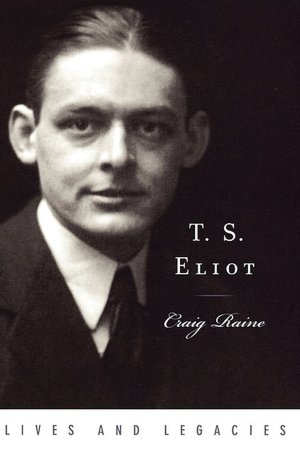 Raine’s study of T S Eliot is a curious book. It clearly assumes
familiarity with the major works, and with the broad shape of the biography, so
is not for first-timers. Yet some of the summary passages, such as the account
of Eliot’s view of the person who suffers and the mind which creates, will not
give anything new to experienced readers. So who is it for? It offers excellent
close readings of some less noticed poems (‘Lune de Miel’ and ‘Dans le
Restaurant’) while skipping important works like ‘Preludes’ and ‘Rhapsody
on a Windy Night’, and it gives only a general impressionistic account of ‘The
Waste Land’. The reading of ‘The Four Quartets’ is too fragmentary to be satisfactory,
while as usual making neat local poits about word choice along the way. The
main thesis of the book is that Eliot’s work is animated by the Arnoldian
Buried Life, the sense of life unlived, emotions unfulfilled. This is just
about made to cohere with the secondary thesis that Eliot is a classicist in
the sense of being sceptical of romantic emotional effusion, and more interested
in the detached depiction of less usual, fugitive emotions. The difficulty here
is that, as Eliot recognised, the terms ‘Romantic’ and ‘Classical’, when
applied as anything other than period terms – and perhaps even then - are too vague to do any useful work.
Raine’s study of T S Eliot is a curious book. It clearly assumes
familiarity with the major works, and with the broad shape of the biography, so
is not for first-timers. Yet some of the summary passages, such as the account
of Eliot’s view of the person who suffers and the mind which creates, will not
give anything new to experienced readers. So who is it for? It offers excellent
close readings of some less noticed poems (‘Lune de Miel’ and ‘Dans le
Restaurant’) while skipping important works like ‘Preludes’ and ‘Rhapsody
on a Windy Night’, and it gives only a general impressionistic account of ‘The
Waste Land’. The reading of ‘The Four Quartets’ is too fragmentary to be satisfactory,
while as usual making neat local poits about word choice along the way. The
main thesis of the book is that Eliot’s work is animated by the Arnoldian
Buried Life, the sense of life unlived, emotions unfulfilled. This is just
about made to cohere with the secondary thesis that Eliot is a classicist in
the sense of being sceptical of romantic emotional effusion, and more interested
in the detached depiction of less usual, fugitive emotions. The difficulty here
is that, as Eliot recognised, the terms ‘Romantic’ and ‘Classical’, when
applied as anything other than period terms – and perhaps even then - are too vague to do any useful work.
The main difficulty of Raine’s book is that the theme of the buried life is strained to breaking
point, as it is used to apply to so many things: Prufrock’s stifling of impulse, the buried
voices in ‘The Waste Land’, the idea of a positive renunciation in ‘Ash
Wednesday’, the dramatization of repressed conscience in the plays and the
spiritual experience in ‘The Four Quartets’. This makes us feel that a whole oeuvre
is being blurred over and made to fit a single idea, a reductive strategy false to the variety of Eliot's writing. Along the way, there
are some scrupulous readings of lines, interspersed with weird tabloidese
one-sentence paragraphs, surprising choices of adjective for a critical work (a
Walcott poem, left largely unquoted, is ‘botched’; an interpretation by George
Steiner is ‘stupid’). The chapter on the Criticism is entertaining for its
comments on inconsistencies and vagueness in Eliot’s work, but Eliot’s
criticism really needs to be traced chronologically and systematically, and
there is too much hopping about from one essay to another. The chapter
defending Eliot against accusations of anti-Semitism is a much-needed
counterbalance to what has become critical orthodoxy; it might be stronger if
Raine had not earlier been vigorously defending TSE from any and all other accusations
(mistreatment of his first wife etc.), making him look like a defence lawyer rather than an impartial
critic (an effect contributed to by the dedication to Valerie Eliot). Some of the readings, such as the contention that Burbank is a dramatic
monologue, which we would see if we knew our Joyce better, seem to me
over-ingenious. Some are brilliantly precise. The book is certainly not a general introduction to a major
writer, but a vigorously argued pursuit of a big idea, the Buried Life that is alleged
figure in the carpet of the whole work from beginning to end. Raine's TSE is certainly
worth reading, and one would generally prefer criticism with a personal touch
like this to a toneless Introductio. But for a general overview of Eliot’s art we need
to look elsewhere.